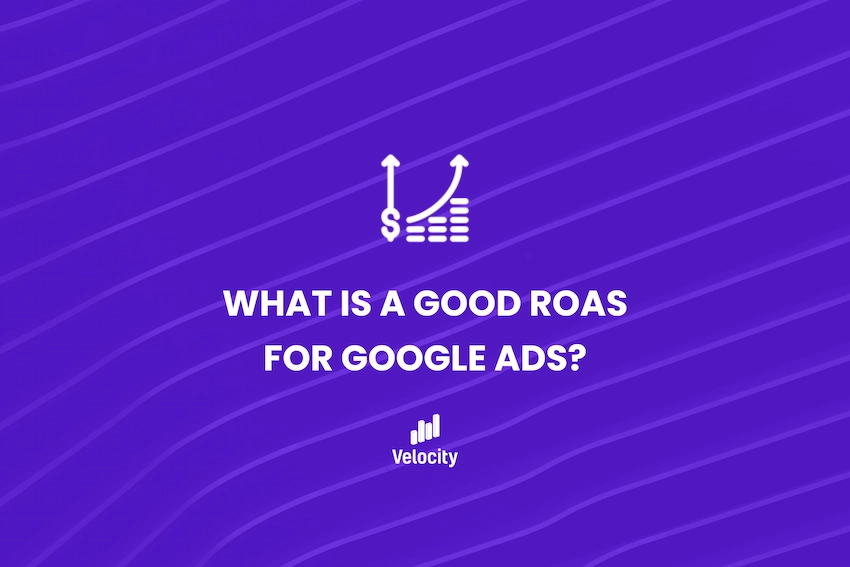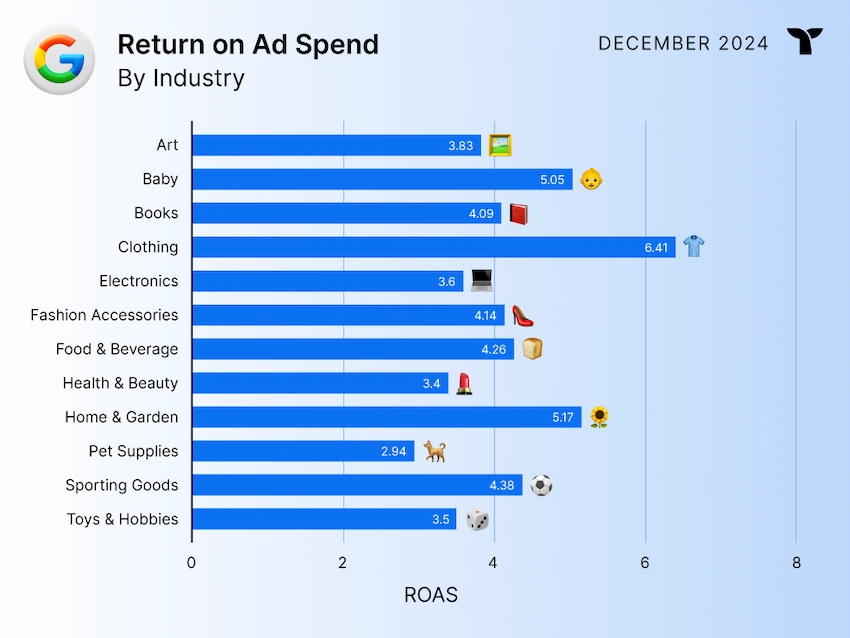What is a Good ROAS for Google Ads?

Google Ads has the potential to be your marketing team’s number one lead gen machine, if you use the right strategy.
One side of the strategy: attention-grabbing, highly targeted ads that land right in the center of high-intent, purchase ready audiences.
The other: meticulously monitoring your key ad metrics to identify what’s going well, what isn’t and where there’s opportunity for improvement.
ROAS, or return on ad spend, is the most important metric for ecommerce companies drilling down into ad performance. By tracking your ROAS, you get a real sense of the results you’re getting from your ad campaigns versus what you’re putting in.
But what are you measuring when you track ROAS and, crucially, what counts as a ‘good’ ROAS? We’ve got you covered – read on for a complete guide.
What is ROAS and what does it measure?
Do you rely on paid advertising in any way, shape or form? If so, return on ad spend should be one of your marketing team’s top metrics to track.
ROAS is simply a measure of how many dollars you get back for every dollar you spend on advertising – in other words, how much revenue your ad campaigns generate for every dollar you put in.
You’ll see ROAS expressed in one of two ways:
- As a ratio, for example, 4:1 ($4 revenue for every $1 spent)
- As a percentage, for example 400% ($4 revenue for every $1 spent)
Tracking your Google Ads ROAS in real time will help you identify:
- Whether you’re reaching the right audiences
- Which of your campaigns and ads are performing best
- Opportunities to optimize ads and campaigns that aren’t performing as well
- Where to channel your marketing budget for maximum returns
You can track ROAS for any online ads platform. In this article, we’re honing in on ROAS for Google Ads specifically, as (in our humble opinion, anyway) it’s the fastest, most powerful ad platform for generating eCommerce revenue – but you can calculate ROAS for Meta Ads, Facebook Ads, or whichever other platforms you’re running your campaign on.
ROAS vs ROI: what’s the difference?
“But isn’t ROAS exactly the same as calculating the ROI for any other business investment?”
Think of ROAS as a hyper-specific ROI calculation. To calculate the overall ROI of your campaign, you’d need to factor in all costs and returns associated with the campaign (for example, agency fees and software platforms). Your ROI is the return on your overall investment in the campaign.
ROAS measures ad spend, and ad spend only.
This means that you can really drill down into the effectiveness of the ads themselves, to the exclusion of everything else. ROI is useful for a number of reasons – but if you want the most accurate picture possible of how your ads themselves are performing, ROAS is the metric you need.
What is a good ROAS for Google Ads?
Google Ads should be your go-to PPC platform if you’re looking to generate revenue quickly, thanks to its ability to reach highly targeted, ready-to-buy audiences with super high visibility ads.
Unfortunately, this means that many of your competitors will want to get in on the action too!
Levels of competition vary by industry – there’s no one-size-fits-all benchmark we can give as an all encompassing ‘good’ figure, but you might find the following benchmarks useful:
- Google Ads’ overall average ROAS is 2:1
- When looking at Search Network ads for high-intent keywords, this can increase to 8:1
With this info in mind, a good ROI is generally taken to sit around 4:1 or higher – though there’s some wiggle room here for industries or niches that are particularly competitive.
We would say, however, that the minimum you should be aiming for is a 3:1 return on your ad spend, no matter what sector you’re advertising in. This is because for anything less than that, your take-home profits are minimal once business costs (e.g., agency fees, ad software, product packaging) are considered, even though you are generating a positive return on your ad spend.
What’s a good ROAS for a PPC agency?
If you’re really looking to take your Google Ads game to the next level, onboarding a specialist PPC agency is a fantastic way to get immediate access to expert Google Ads professionals with hundreds of thousands of dollars’ worth of campaign spend behind them.
Obviously, there are fees you’ll need to pay your agency for their services (though these might not be as high as you expect), so you’ll be expecting a higher ROAS to offset this. A PPC agency with a genuinely talented team will be able to put their money where their mouth is – ask for case studies and testimonials to gauge what sort of results to expect.
For some of our clients, we’ve achieved an over 1200% increase in ROAS. Read how.
Is there any reliable data for average Google Ads ROAS across different industries?
Unfortunately there’s no go-to source of info for different industry benchmarks. Google doesn’t release this data, and individual businesses are, quite fairly, a little conservative about releasing recent financial data to the public.
A number of PPC agencies and ad software providers publish Google Ads benchmark reports – these are based on data from their client bases, so will naturally vary in scope. Our advice, if you use these: try and establish the scope of their data, and look for ways of corroborating conclusions with other sources where you can.
If you’re in the consumer goods industry, we find that Triple Whale’s benchmarking report contains some useful insights, based on over 7,000 client accounts on their BI platform:

How to calculate ROAS?
You can calculate your ROAS at the end of a campaign, to gauge your overall performance. You can also track it in real time for ongoing insights into your campaign and opportunities for optimization.
The calculator itself isn’t difficult:
- Determine how much you have spent on ads
- Determine the total revenue that you can attribute from these ads – for example by tracking the sales or closed deal value that came through via your ads
- Divide your revenue by your costs – this gives you your ROAS in ratio form
- Multiply by 100 – this gives you your ROAS in percentage form
For example:
You’re an HVAC business that has spent $3,000 on Google Search Network ads this month.
Tracking the sales that came through those ads, you calculate an ad revenue of $15,000.
To get your ROAS, you divide your revenue ($15,000) by your costs ($3,000).
- This gives you the result of 5, or an ROAS ratio of 5:1.
- You multiply this by 100 to get an ROAS percentage of 500%.
What tools can I use to track ROAS?
Whilst manually calculating ROAS is easy, accurately attributing revenue to different ad campaigns can be time consuming – and no-one needs an extra thing at the bottom of their to-do list.
Instead, let your ad platforms do it for you.
Most ad platforms will calculate ROAS automatically, and allow you to track it in real time across your campaign. In Google Ads look out for the ‘Conv. Value / Cost’ metric – just make sure that the Conversion value you’re counting is only for actual sales, then you’re good to go.
Get an accurate quote for Google Ads services
At Velocity, we’re all about building PPC campaigns customized entirely to your goals.
We can give you some solid baseline figures for ROAS. And if you share some info about your business, growth plans, and business model, we’ll be able to share more accurate predictions.
If you want to find out more about our advertising services and how much they cost, get in touch today for a quick chat – we love meeting people, and there’s no pressure to commit to anything after the conversation.
